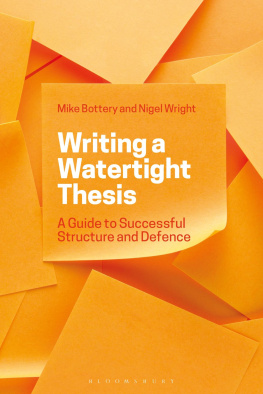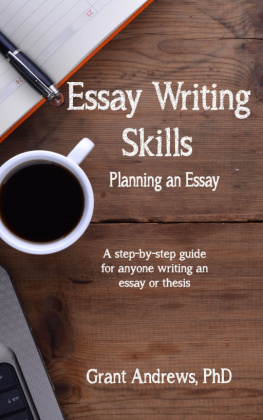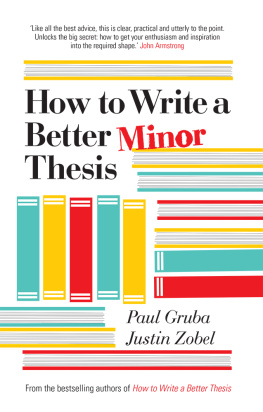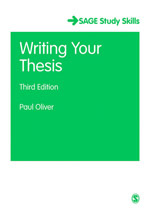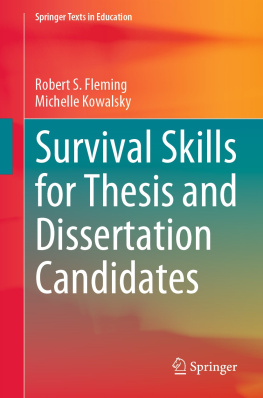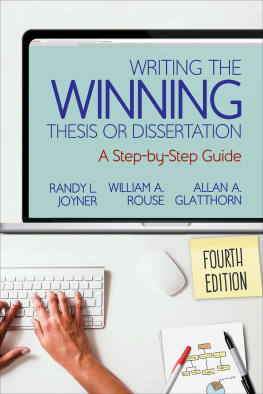Writing a Watertight Thesis
Also available from Bloomsbury
Reflective Teaching in Higher Education , Paul Ashwin
Successful Dissertations , Caron Carter, Mark O'Hara, Janet Kay, Jonathan Wainwright and Pam Dewis
Taking Control of Writing Your Thesis , Kay Guccione and Jerry Wellington
Writing a Watertight Thesis
A Guide to Successful Structure and Defence
Mike Bottery and Nigel Wright

Contents
There are many people we would like to thank in helping us reflect upon our practice of supervision, in approaching the writing of this book, and in commenting upon various drafts as it developed.
First, we would like to thank all those students we have worked with over three decades, and from whom we have learnt so much about the practice of supervision.
Second, we would like to thank all those successful doctoral candidates from our own institution and from around the world who graciously agreed to the use of their experiences and their doctoral work to illustrate particular points throughout the book.
Third, we would like to thank the large number of colleagues from other institutions who have invited us to act as external examiners at their institution, and so expand our experience; and many of whom for also acting as external examiners for us.
Finally, we would like to thank those individuals who helped us specifically with the book, either by reading individual chapters or by engaging in discussion on the project: Julian Stern, Peter Gilroy, Elaine King, John Greenman, Mike Whitehouse, Tim Scott, and Clive Opie.
Writing a doctoral thesis can be an arduous and confusing process, and particularly at the beginning, when students may understand that they need to produce a strong structure for the entire work, but may be unsure about how to do this in a clear, rational and convincing manner. This book demonstrates how to produce such a watertight thesis how to set up a thesis structure and how to maintain it throughout the doctoral journey. As the book explains, the key to such watertightness begins with the ability to work out what the main research question of the thesis is, and what are the sub-questions derived from it, the answers to which collectively answer this main one. If then you follow and structure this approach throughout your thesis, you can be confident that your examiners will find it extraordinarily difficult to fail your thesis on structural grounds.
Writing a Watertight Thesis illustrates this argument with examples of how theses can be made more watertight. In many cases the examples are ones taken from genuine theses. These were only used once permission had been granted by the authors, in terms of thesis content, our comments upon these theses, and the identification of the authors identities. All of these theses are referenced at the back of the book. Other examples were created by us with advice from individuals more specialized in these areas to demonstrate how widely the approach taken can be adopted. The book also provides doctoral candidates with numerous exercises enabling them to do the same kinds of things within their own thesis.
Finally, we have taken the decision to not include detailed discussion of action research and grounded theory methodology approaches in this book. We still believe that the approach taken in this book is applicable to both: they both need to set up a thesis structure and maintain it throughout the doctoral journey, and they both need a main research question and sub-research questions, which collectively answer the main one. Nevertheless, discussion of the individual complexities of these two approaches would require a disproportionate amount of space in a relatively short book. In the circumstances, we recommend a number of more specifically focused books for those interested in taking these approaches (see Appendix 1).
Writing a Watertight Thesis will then provide greater clarity to the doctoral journey for many students: it will make the whole process more comprehensible and enjoyable, and crucially, it will make the entire thesis much easier to defend.
In the first section of this book, key issues of structuring at the beginning of a thesis are examined. Chapter 1 begins this process by examining the need for, and the meaning of the term watertight. Chapter 2 gives advice on developing the structure of a research proposal so that it works to your advantage in your application and if you get called for any interview. This proposal then is very likely the first structured conception of your thesis structure. Finally, Chapter 3 explores the early meetings you will have with your supervisors, and how such meetings can help in developing this doctoral structure, as your initial conceptions move into a more concerted framing of your thesis.
Introduction
A generation or two ago, it was fairly normal for doctoral students to arrive at a university and spend the first few months reading around a topic until at some time during the first year, they came to an understanding of what the thesis might consist. Whilst reading round a subject is an important early activity, students and supervisors alike now face new pressures. Students now have strong demands to finish on time. They may be paying for this study themselves, they may have a scholarship or funding body which expects completion within the allotted time period and they may have a family to support. Supervisors, irrespective of national location, want students to finish on time with a quality piece of work, which launches them along their chosen career path. They also tend to live with increased work pressures and external expectations of students completing on time. Both student and supervisor then have strong reasons for wanting to waste as little time as possible, to establish the focus of the thesis fairly early on in the study, how this can be framed to suit the specified length, and then developed during the period of study so that satisfactory data are gathered to provide the final answers in the concluding chapters.
Yet our joint experience of half a century of supervising and examining over 160 doctoral theses, with students from virtually every continent on the planet, and from a wide range of academic and professional backgrounds, is that lots of doctoral students still come to university with limited understanding of what to expect, what a good doctorate looks like, and how to spend their time on study most profitably. They can find it very difficult to understand what needs to be done at the beginning of their thesis, and particularly in terms of its overall structure. This book provides them with these understandings from the start, and in particular helps them establish their thesis structure in a convincing and clear way, so that they can maintain this through to the end of their programme. To do this, they need to produce a watertight thesis.
This book is written for students in the first place, but it also is likely to be useful for supervisors new to the task, and for those beginning to examine doctorates. To start, then, we want to explain how watertight theses have major strengths that other theses may lack. We also need to reassure you that what is recommended is not just the parochial approach of a couple of UK academics but also applicable internationally.
So, what is a watertight thesis?
A watertight thesis is fundamentally one demonstrating such sound structural integrity that it is nearly impossible to demolish its main argument. It means that if your thesis is structured in this way, then an examiner will find it enormously difficult to fail it on structural grounds, a critical aspect of doctoral quality. The suggestion of needing to be watertight is borrowed from shipbuilding, where the builders of river and sea-going vessels need at all costs to keep the water out, that is to ensure that the internal parts of the ship and the people on board, along with any cargo, remain dry and afloat. To do this, shipbuilders need to adhere to a number of principles. In particular, they need to ensure

